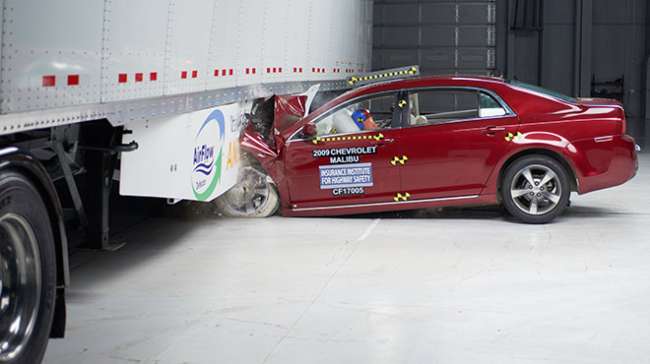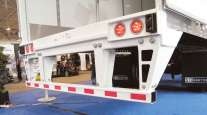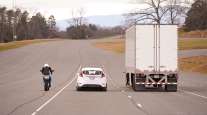Senior Reporter
Insurance Institute Conducts Successful Test of Side Underguard Protection

An aftermarket device that attaches to the sides of a tractor-trailer successfully prevented a midsize car from sliding underneath the trailer in a 40 mph crash test, Insurance Institute for Highway Safety officials said.
It was the second test by IIHS of the AngelWing, produced by Airflow Deflector Inc. and the only side underride protection device on the market, IIHS Senior Vice President Russ Rader said.
A prior successful test was conducted several months ago at 35 mph. A 40 mph crash involves 30% more energy than a 35 mph crash, according to the safety group.
“We’ve made a lot of progress with rear underride protection,” Rader told Transport Topics. “This test shows that side underride protection is within reach as well. These crashes are devastating.”
Two years ago, 301 of the 1,542 passenger vehicle occupants killed in two-vehicle crashes with a tractor-trailer died when their vehicles struck the side of a tractor-trailer. That total compares with 292 people who died when their passenger vehicles struck the rear of a tractor-trailer, according to the institute.
Underride occurs when a smaller vehicle crashes into a truck and goes completely or partially underneath it, increasing the likelihood of serious injuries to people riding in the smaller vehicle. Tractor-trailers are required under federal regulations to have underride guards on their rears, but not on their sides.
A 2015 National Highway Traffic Safety Administration proposed rule, yet-to-be-finalized, called for motor carriers to strengthen rear underride guards to a standard already in place in Canada, but one that most trailer makers in the United States already have exceeded, Rader said. However, there is no standard for side underrail guards.
The Aug. 29 test used a 2009 Chevrolet Malibu that struck the center of a 53-foot-long dry van trailer at 40 mph.
The side guard bent but didn’t allow the car to go underneath the trailer, and the car’s air bags and safety belt properly restrained the dummy in the driver seat, IIHS said.
The group said measures taken from the dummy showed there would be a low likelihood of injuries in a similar real-world crash.

Zuby
“Broader use of devices like this one, combined with continued improvements to rear underride guards, would go a long way toward reducing deaths in large truck crashes,” IIHS Executive Vice President David Zuby said in a statement.
The latest test was conducted during the institute’s second roundtable on the problem of truck underride crashes held at the IIHS Vehicle Research Center in Ruckersville, Va.. It was co-sponsored by the Truck Safety Coalition and AnnaLeah and Mary for Truck Safety. Sisters AnnaLeah and Mary Karth were killed in May of 2013 in Georgia when the car being driven by their mother was hit by one truck and driven into another that did not have underride guards.
The roundtable discussion centered on finding a strategy to create interest in side underride protection in public and Congress, Rader said.
Some transportation leaders are hoping that self-driving vehicles will eliminate crashes entirely, said David Harkey, who directs the University of North Carolina Highway Safety Research Center.
“While technology holds a lot of promise, it’s going to take a long time to get there,” Harkey, a participant in the IIHS roundtable, said in a statement. “There are things we can do now to save lives, and side underride guards are a perfect example.




